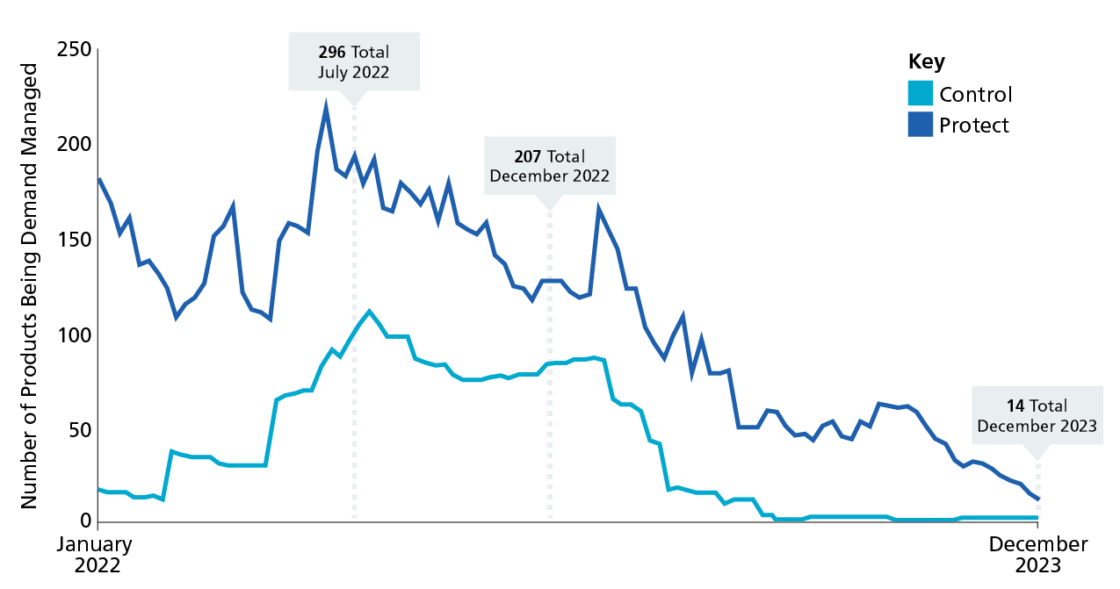Greater Supply Chain Collaboration Leads to Significant Reduction in Demand Managed Products Over the Past 18 Months
In common with other healthcare organisations, our experience through the COVID-19 pandemic highlighted the importance of ensuring a resilient supply chain for NHS trusts, through our delivery networks and suppliers’ supply chains.
Ensuring that all NHS trusts have equal access to key consumables required to provide patient care remains a top priority. In certain instances, this requires us to implement demand management processes for products.
The purpose of demand management is to maintain continuity of supply of critical products to the NHS where normal supply is disrupted, meaning NHS demand will be greater than the available stock. Demand management aims to ensure that stock remains available and is shared fairly, albeit in reduced quantities, across the NHS until normal supply can be restored.
In July 2022, there were 296 products which were being demand managed. However, over the last 18 months we have seen a 95% drop to just 14 products in December 2023.
This significant decrease has been achieved through the following measures being applied:
- Investment in a new central resilience function. The role of our Resilience team is to prevent supply chain disruptions from occurring where possible. However, when they do happen the team monitors the severity of the disruption. They look to respond quickly and effectively and to resolve the disruption with minimal impact to customers.
- Implementation of clear cross functional process for managing supply chain disruptions.
- Consultation with customers around how demand management affects them, via the Resilience Steering Group.
- Involvement of Resilience Steering Group members in the Shortage Management Oversight Group (SMOG) chaired by the Department of Health and Social Care. The group governs application of demand management, meaning customer input is provided whenever any product is placed on demand management.
Demand Managed Products Status

- Introduction of new internal processes to govern application of demand management.
- Working closely with suppliers to reduce the amount of time products remain on demand management.
Demand management remains a necessary tool for managing supply disruptions and there may be an increase in the numbers of products managed this way if the market deteriorates. However, the steps we’ve taken mean that customers can be assured that all reasonable steps are taken to reduce the impact of demand management on their teams.
Tom Brailsford, Head of Resilience, NHS Supply Chain
We continue to monitor and where necessary increase stockholding levels in our warehouses and with our suppliers for high demand product categories. This helps ensure that products are available to order.
This is just one of the ways we are ensuring we develop a resilient supply chain. As part of our category management work, we are:
- Increasing visibility of our supply chains across all suppliers. This will enable us to detect potential upcoming supply chain shocks earlier, allowing us to plan accordingly.
- Collaborating with customers to pilot an approach to product segmentation by clinical risk, allowing resilience strategies to be deployed appropriately and proportionately.
- Ensuring we have an appropriate number of suppliers and from multiple geographies that can cover customer demand which will lessen the time and impact of a disruption.
- Mapping alternatives to all of our products, ensuring that they are clinically accepted where necessary.
- Checking our suppliers have robust Business Continuity Plans that cover resilience in place.
As we start 2024, global supply chains remain challenging due to factors such as raw material shortages, disruptions to manufacturing and transport, and geo-political events. We understand the impact this can have on frontline patient care.
We will continue to drive forward programmes to both anticipate and address issues as they arise. We will strengthen resilience across all aspects of our supply chain, from the strategic sourcing decisions taken; through how we manage inventory; to connecting visibility of inventory across the supply chain.
Links section
-
Demand Management
Further information on demand management, including details of products currently subject to demand management and how to request more.
-
Supply Chain Resilience
Important information about current initiatives to improve our supply chain resilience.
-
Important Customer Notices
Important notices about product availability, for example supply issues, Field Safety Notices, delisted products.
